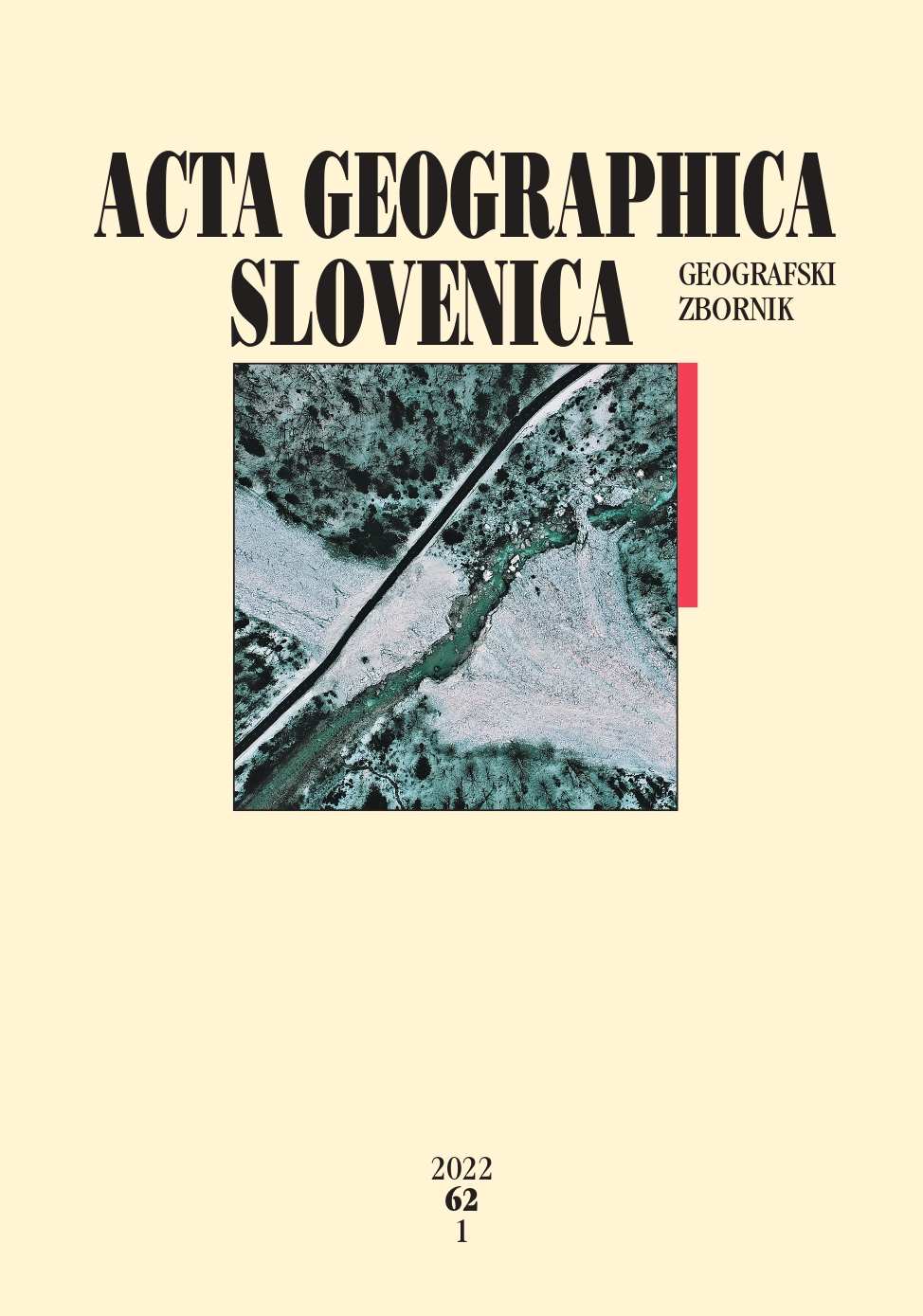The Kolpa as a border river in the newspaper Slovenski narod, 1868–1914
DOI:
https://doi.org/10.3986/AGS.7555Keywords:
environmental history, border, border river, newspaper Slovenski narod, nineteenth century, Kolpa, Slovenia, CroatiaAbstract
The article analyzes the portrayal of the Kolpa as a border river in the leading Slovenian liberal newspaper Slovenski narod from 1868 to 1918. A border river is understood both in terms of the political concept of a border river and in terms of a natural border in a landscape. The differences between these two concepts can occur over long historical periods and can change significantly (e.g. due to floods, changes in the riverbed and the loss or acquisition of the status of a border river). In the period examined, the Kolpa formed an internal border between the Hungarian and Austrian parts of the Habsburg Monarchy. In addition, since the Late Middle Ages it has been a political border between Carniola and Croatia. The article analyzes the following aspects: a) the Kolpa as a border and a political concept, b) the management of the Kolpa (construction and maintenance of bridges, traffic bans, and restrictions), c) the Kolpa as a dangerous river, and d) border disputes.
Downloads
References
Amoore, L., Marmura, S., Salter, M. B. B. 2008: Smart borders and mobilities: Spaces, zones, enclosures. Surveillance and Society 5-2. DOI: https://doi.org/10.24908/ss.v5i2.3429
Baud, M, Van Schendel, W. 1997: Toward a comparative history of borderlands. Journal of World History 8-2.
Bufon, M. 2001: Geografija obmejnosti, čezmejne regije in oblike čezmejne povezanosti. Geografski vestnik 73-1.
Bufon, M. 2002: Aplikativni vidiki politične geografije v planiranju integracije in razvoja kontaktnih prostorov. Dela 18. DOI: https://doi.org/10.4312/dela.18.281-298
Bufon, M., Sanguin A. L. 2015: Geografija obmejnosti in raznolikost sodobnih političnih meja. Geografski vestnik 87-1. DOI: https://doi.org/10.3986/GV87101
Cvirn, J. 2015: Dunajski državni zbor in Slovenci (1848–1918). Celje.
Eigmüller, M. 2006: Der duale Character der Grenze. Grenzsoziologie, die politische Strukturierung des Raumes. Wiesbaden.
Frantar, P., Hrvatin, M. 2005: Pretočni režimi v Sloveniji med letoma 1971 in 2000. Geografski vestnik 77-2.
Gleditsch, N. P., Furlong, K., Hegre, H., Lacina, B. Owen, T. 2006: Conflicts over shared rivers: Resource scarcity or fuzzy boundaries? Political Geography 25-4. DOI: https://doi.org/10.1016/j.polgeo.2006.02.004
Hepe, B., Janjič, K., Mikuž, S., Živko, I. 2011: Zgodovina carine na Slovenskem od antike do slovenske osamosvojitve. Ljubljana.
Jurčič, J. 1982: Zbrano delo. Ljubljana.
Keber, K. 2003: Epidemije na Slovenskem: Primer kolere v 19. stoletju. M.Sc. thesis, University of Ljubljana. Ljubljana.
Komac, B., Natek, K., Zorn, M. 2008: Geografski vidiki poplav v Sloveniji. Geografija Slovenije 20. Ljubljana.
Koselleck, R. 2002: The practice of conceptual history: Timing history, spacing concepts. Stanford.
Landwehr, A. 2008: Historische Diskursanalyse. Frankfurt am Main.
Perko, D., Zorn, M., Ciglič, R., Breg Valjavec, M. 2019: Changing river courses and border determination challenges: The case of the Slovenian–Croatian border. Cham. DOI: https://doi.org/10.1007/978-3-030-04750-4_11
Pipan, P. 2007: Cross-border cooperation between Slovenia and Croatia in Istria after 1991. Acta geographica Slovenica 47-2. DOI: https://doi.org/10.3986/AGS47204
Pipan, P. 2008: Border dispute between Croatia and Slovenia along the lower reaches of the Dragonja River. Acta geographica Slovenica 48-2. DOI: https://doi.org/10.3986/AGS48205
Rustja, K. 1994: Dolenjske proge. Tiri in čas. Ljubljana.
Schall, G. 2001: Der österreichisch-ungarische Dualismus als Integrationskonzept. Hamburg.
Tapia Ladino, M. A. 2017: Borders, mobility and the transborder space: Reflections for a discussion. Estudios Fronterizos 18-37. DOI: https://doi.org/10.21670/ref.2017.37.a04
Vatovec, F. 1968: Ob zibeli “Slovenskega naroda” pred sto leti. Ob stoletnici ustanovitve “Slovenskega naroda” 1868–1968. Maribor.
Von Hirschhausen, B., Grandits, H., Kraft, C., Mueller, D., Serrier, T. 2015: Phantomgrenzen im östlichen Europa: Eine wissenschaftliche Positionierung. Phantomgrenzen: Räumen und Akteure in der Zeit neu denken. Göttingen.
Zajc, M. 2003: Problem slovensko-hrvaške meje v 19. Stoletju: Žumberško vprašanje. M.Sc. thesis, University of Ljubljana. Ljubljana.
Zajc, M. 2006: Kje se slovensko neha in hrvaško začne: Slovensko-hrvaška meja v 19. stoletju. Ljubljana.
Zajc, M. 2012: Sotla, majhna voda. Reka Sotla kot naravna, politična in ideološka meja v 19. in začetku 20. stoletja. Zgodovina za vse 19-1,2.
Zajc, M. 2017: The border river phenomenon: The example of the River Mura. Contributions to the contemporary history 57-3.
Zajc, M. 2018: The border monster refuses to die. Südosteuropa 66-1. DOI: https://doi.org/10.1515/soeu-2018-0007
Zoll- und Staats- Monopols-Ordnung. 1835. Wien.
Zorn, M., Breg Valjavec, M., Ciglič, R. 2018: Kartografski viri in viri daljinskega zaznavanja ter njihova uporabnost za spremljanje dinamike rečnega toka na primeru mejnih odsekov Drave in Dragonje. Ustvaranje slovensko-hrvaške meje. Ljubljana.
Downloads
Published
How to Cite
Issue
Section
License
Copyright (c) 2022 Marko Zajc

This work is licensed under a Creative Commons Attribution-NonCommercial-NoDerivatives 4.0 International License.









